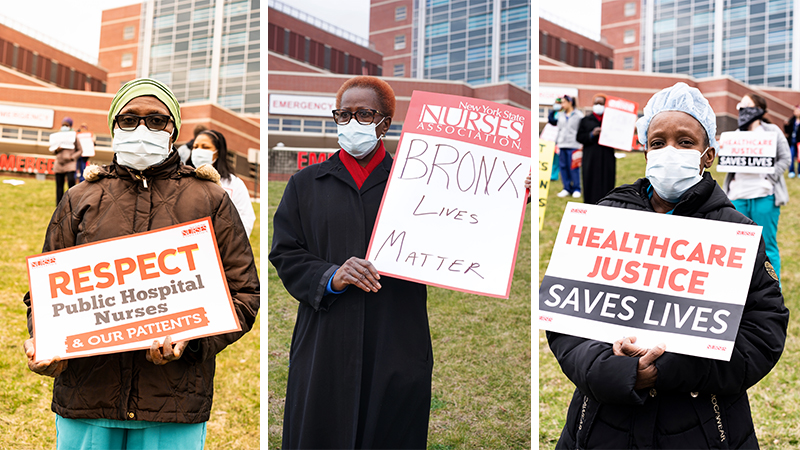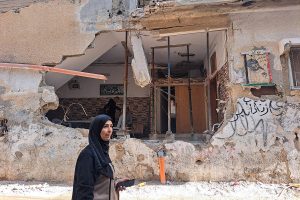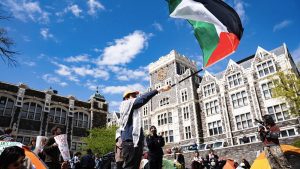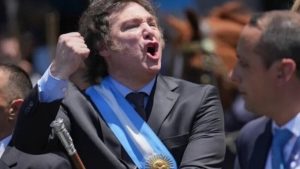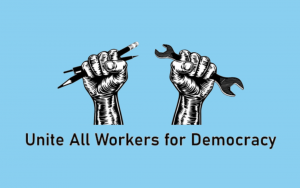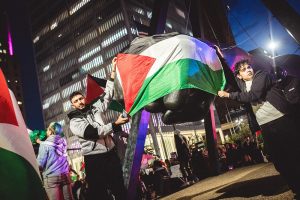Two years ago, I moved to Bronx, NY for post-graduate medical training. My passions for health equity, activism, and advocacy and my longitudinal drive to keep my communities healthy made me excited to practice medicine in a predominantly Black and Latinx neighborhood. Although medicine is an implicitly inequitable microcosm of society — a racist, white-centric, cissexist, heterosexist, settler-colonialist patriarchy dependent on power dynamics to perpetuate matrices of oppression — my patients remind me of my family and my community. They make me feel like I am home.
As the COVID-19 crisis has erupted, legacies of structural violence have been made exceptionally clear. As a doctor — a Black doctor — the past few months have been nothing short of horrifying. Black and Latinx New Yorkers have been hospitalized at higher rates and are dying at higher rates than our white counterparts. A borough where 56.4% of residents self-identify as Hispanic or Latinx, and 43.6% self-identify as Black or African American, the Bronx quickly overcame Queens, Brooklyn, Staten Island, and Manhattan for per-capita case rates, hospitalizations, and mortalities.
Social Determinants of Health Equity
Zip code is the greatest predictor of one’s health is commonly a catch-phrase introduction to social determinants of health as a way to analyze how systems outside of healthcare delivery affect health. Social determinants of health include individual-level resources like education and income, neighborhood or community-level resources like housing and transportation, hazards or toxic exposures like pesticides and vermin, and opportunities like education and justice. According to the most recent data, 29.7% of Bronx residents live at or below the federal poverty line. In Bronx homes, 39.4% (vs 24.1% NYC) reported cockroach infestations, 23.4% (vs 15.5% NYC) reported rat or mice infestations, and 12.9% (vs 9.5% NYC) reported mold infestation – all of which can exacerbate chronic respiratory diseases like asthma and COPD. Furthermore, many frontline workers across NYC — be they working in hospitals, nursing homes, grocery stores, pharmacies, food service, conducting trains and buses, cleaning or doing custodial work — are Black, Indigenous, and People of Color (BIPOC).
For the sake of health equity for racialized people, social determinants of health cannot be taken at face value. We must interrogate the context and history of existing resources, exposures, and opportunities using an equity framework. As Dr. Camara Phyllis Jones states, social determinants of equity must “examine structures, policies, practices, norms, and values.” We must name, identify, and intentionally deconstruct racism, capitalism, white supremacy, xenophobia, and the kyriarchy of oppression.
Environmental Racism and Unequal Enforcement
In the context of existing health inequities, the disparities of COVID-19 are unsurprising. At the onset of the coronavirus outbreak, people living with chronic cardiac, pulmonary, or immunosuppressive conditions were thought to be at highest risk of serious complications and death. Compared to other NYC boroughs, the Bronx has the highest percentage of teenagers and adults who have ever been diagnosed with asthma (27.7% and 17.0%, respectively). Multiple heavily accessed freeways weave across the borough, connecting industrial facilities in close proximity to housing complexes, apartment buildings, and outdoor spaces. This causes increased exposure to fine particulate matter (PM2.5) at an average microgram per cubic meter of 7.3 in the Bronx (the NYC average in 2018 was 7.0 mcg/m3) and undoubtedly increases the prevalence and severity of asthma among Bronx residents in a phenomenon known as pollution inequity, described in 2019 by Tessum et al as “the extent to which groups disproportionately contribute to or bear the burden of pollution.”
By the numbers, PM2.5 pollution inequity is represented by 183.6 per 100,000 child emergency department visits (NYC average 97.8), and 83.7 per 100,000 adult emergency department visits in the Bronx (NYC average 42.2). Pollution inequity is 210.4 per 100,000 child emergency department visits (NYC average 118.8), 45.0 per 100,000 child hospitalizations (NYC average 24.0) attributable to ozone (O3) exposure. Ozone pollution inequity is 102.8 per 100,000 adult emergency department visits (NYC average 24.0) and 13.4 per 100,000 adult hospitalizations (NYC average 6.6). Even outside of a pandemic, pollution inequity and environmental racism make it difficult for many of my patients in the Bronx to simply breathe.
The lasting effects of early 20th century redlining practices, which designated over 80% of Bronx as either “Grade C: Definitely Declining” or “Grade D: Hazardous,” are clear in maps that outline current health disparities and in the distribution of where working-class people live now. When New York City enforced a shelter-in-place order in March, I wondered how disease burden would shift to those considered the “essential workforce” — mostly working-class people, service workers, immigrant communities, undocumented folks, and people of color. Although the physicians in my hospital for the most part look nothing like our patients, the majority of the other hospital workers — nurses and nursing assistants, environmental and custodial services, nutrition and food services, phlebotomists, lab and imaging technicians, patient transporters, security guards, secretaries and administrative staff — are very much representative of the Bronx. They too are at tremendous risk of exposure. Becoming seriously ill in an intentionally inaccessible capitalist healthcare system has far-reaching consequences. Many of the patients I care for are unable to stay home due to their designation as essential workers. Many who were unable to stay home were also unable to physically distance themselves from other people in their household, which sometimes resulted in simultaneous hospital admissions for multiple household members.
When mandated universal masking was implemented city-wide in April, I worried how this rule would be enforced in an already predatory police state. The United States is the incarceration capital of the world, and New York State has an incarceration rate of 443 per 100,000 people, which is higher than entire nations including the UK (139 per 100,000 people) and Canada (114 per 100,000 people). The carceral system is inherently a white supremacist system, with Black, Native, and Latinx people over-represented in jails, prisons, and detention centers. Time and time again, police and Immigrations and Customs Enforcement (ICE) have demonstrated little regard for the lives of Black, Latinx, and Native lives. They assault, detain, and arrest with impunity, regardless of the video evidence. When ICE masqueraded as healthcare professionals in order to get into at least one home, it was abundantly clear that a system intent on dehumanizing subjects of systemic oppression would not cease during a crisis. At previous actions and protests I had attended around the city, comrades were detained and arrested for covering their faces. I imagined who would be permitted to use scarves, bandanas, and other alternative face coverings without compromising their physical safety. I contemplated how many more gentrifiers would call for police involvement to enforce rules they themselves seemingly were not required to follow. Although the white supremacist systems will continue as usual when this is over, the systemic damage and exploitation within my community is only magnified in this pandemic.
Medicine as a Culprit and the Importance of Community Care
Much of modern medicine was developed by experimenting on enslaved, indentured, and otherwise exploited Black and non-Black people of color. Structural oppression, structural racism, and capitalism contribute to a healthcare delivery system that is fundamentally unjust and inequitable. Medicine continually perceives race as a biological construct rather than a sociopolitical one, reporting differences in lung or kidney function and responses to medications and therapies as inherent among people who are perceived as racialized. As discussions from Italy arose regarding rationing care, I predicted that the supremacy inherent in medicine would lead to further de-prioritizing BIPOC, people with disabilities, people who are immunocompromised, people experiencing homelessness, elderly and aging folks, and those whose identities align with multiple oppressed categories from receiving intensive and potentially life-saving interventions. The underlying question: when everyone is sick, who deserves to live? In the absence of an intentional and equitable plan, history dictates that any discussion about rationing care will implicitly harm and kill BIPOC.
In the last century, the people of the Bronx have demonstrated many times over the importance of solidarity and unity in the fight against corrupt medical care. The spirit set by The Young Lords taking over Lincoln Hospital and demanding community control of facilities in order to provide adequate and accessible care lives on in the activism across grassroots organizations like Take Back The Bronx, La Morada Restaurant, NYC Shut it Down, Bronx Mutual Aid Network, and Northwest Bronx Community and Clergy Coalition. Community care has always been at the forefront, and in this pandemic it has transformed into well-oiled mutual aid networks, direct action via distribution of meals and masks, advocacy for the release of all our loved ones behind bars via #FreeThemAll, advocacy for a human right to housing via #HomelessCantStayHome, and support for large-scale rent strikes with calls to #CancelRent. Solidarity, not charity, and we keep us safe are synergistic and necessary mentalities for navigating this crisis.
A fair livable wage, physical protection in the workplace, economic protection during illness or unemployment, and accessible medical care have been demanded by workers since the beginning of the labor movement. The radical roots of the working class send a unifying message to essential workers across professions today: we cannot rely on the mercy of our employers to receive adequate or even basic protections and services. Corporate greed has no conscience. As a doctor, COVID-19 has heightened my awareness that my experience is most aligned with other workers inside and outside of the hospital. We are only as healthy as the sickest person in our society. In this crisis especially, all workers must support each other in the fight for personal protective equipment (PPE), expanded sick-leave, commensurate pay, access to high-quality medical care, physically-distanced working conditions, and clean workplaces. Our struggles are intrinsically connected. Essential workers have more in common with each other than we do the multi-millionaire hospital CEOs and billionaire tech CEOs.
As a physician, I have borne witness to how a novel respiratory virus can devastate a neighborhood whose health has been deeply shaped by environmental racism, racial capitalism, and historical disinvestment in a country founded on genocide and enslavement. This pandemic-scale crisis of death is nowhere near as apparent as it is in the hospital. It is apparent in the astounding numbers of emergency codes called overhead and in the overflowing morgues. It is apparent in the tears of my patients at a new diagnosis of COVID-19. It is apparent in the fear in the eyes of my patients, in the stories of multiple hospitalizations and deaths per household. This pandemic is nothing short of state-sanctioned violence. It has decimated the Bronx. I know that when this is over, the absence of so many loved ones and community members will leave us forever unsettled. I know we are all we’ve got. And I know we are all we need.


